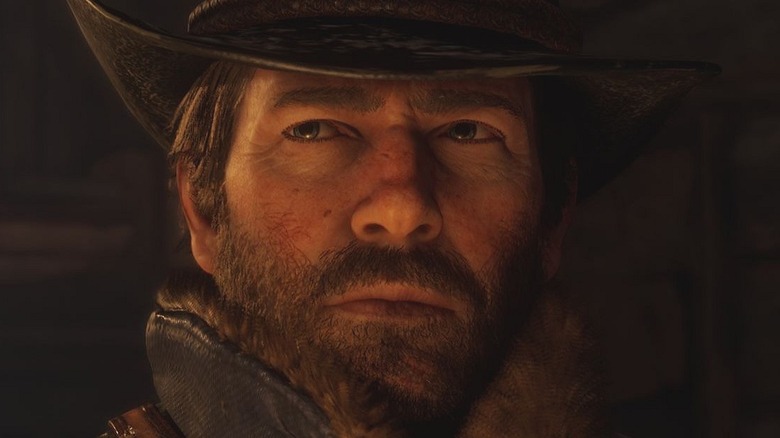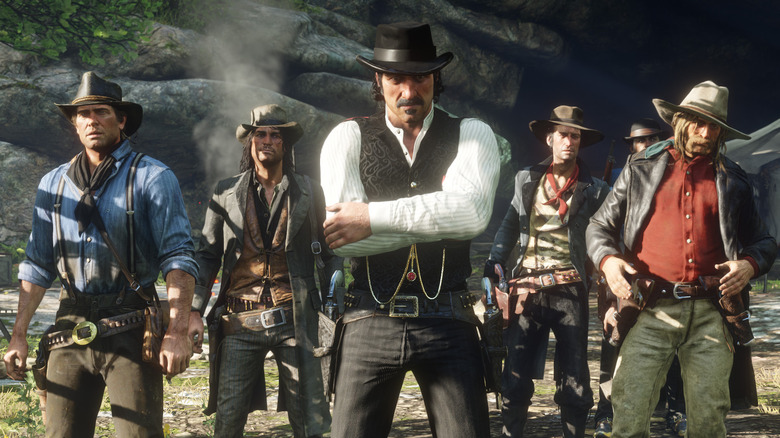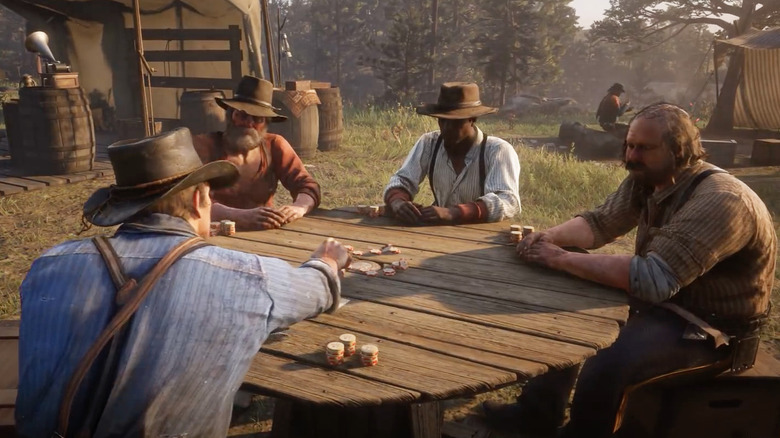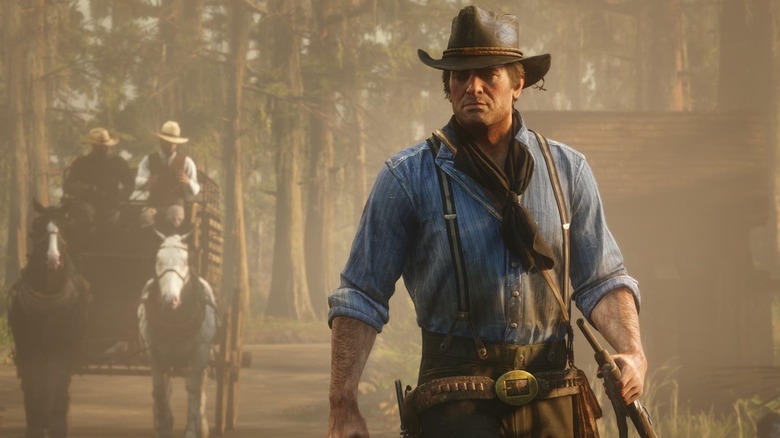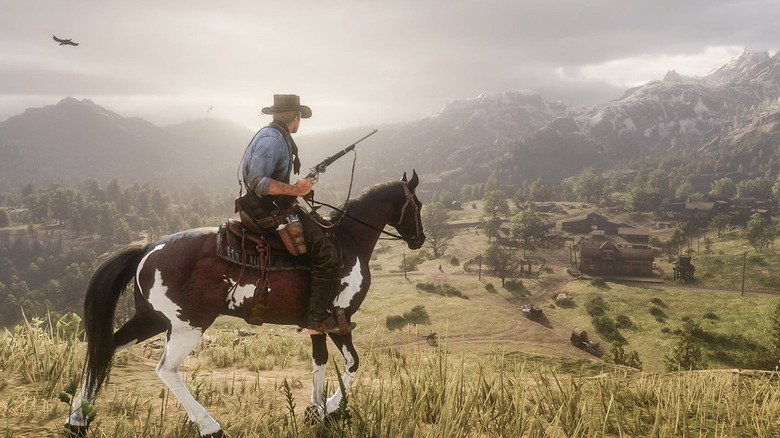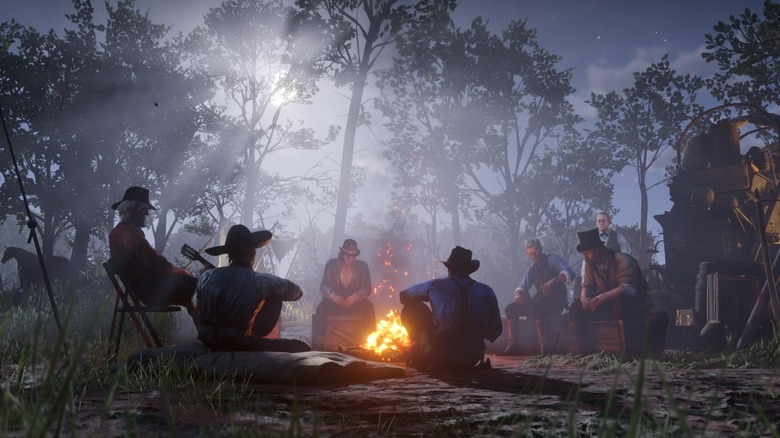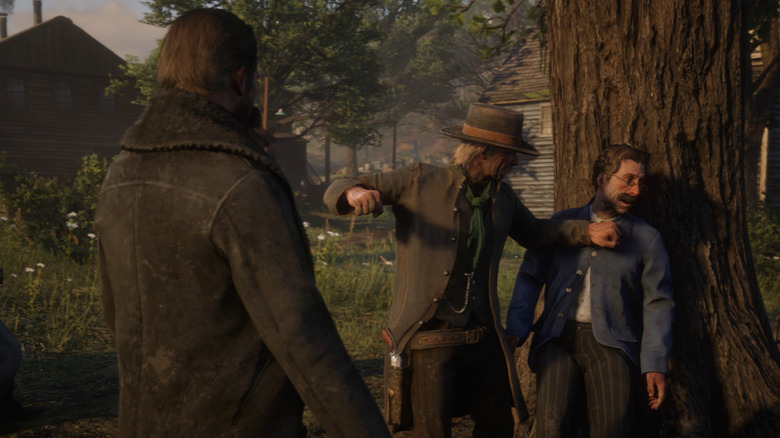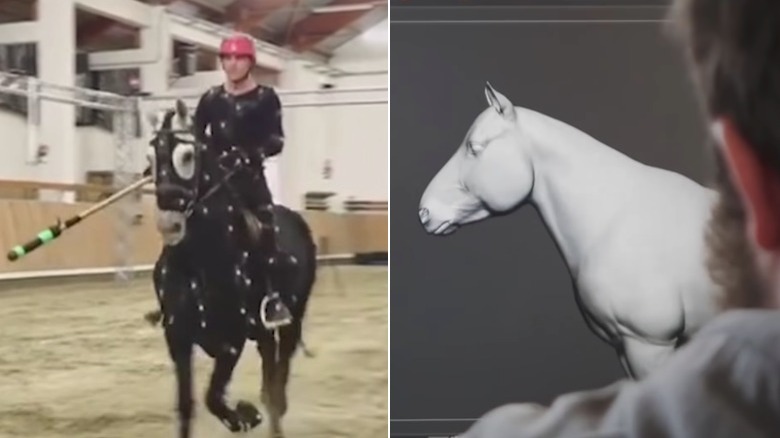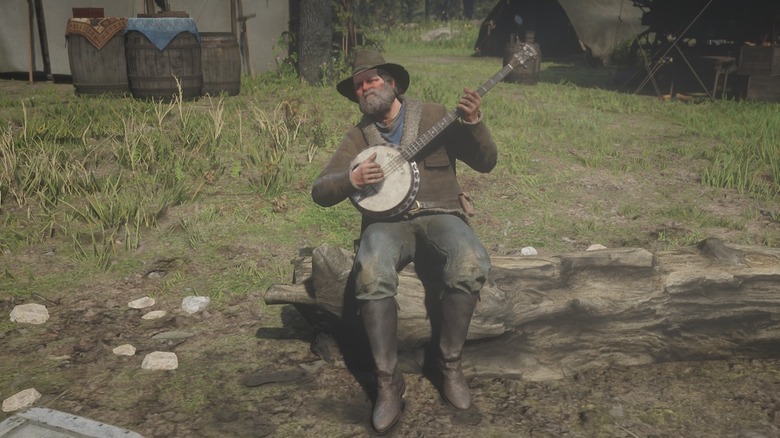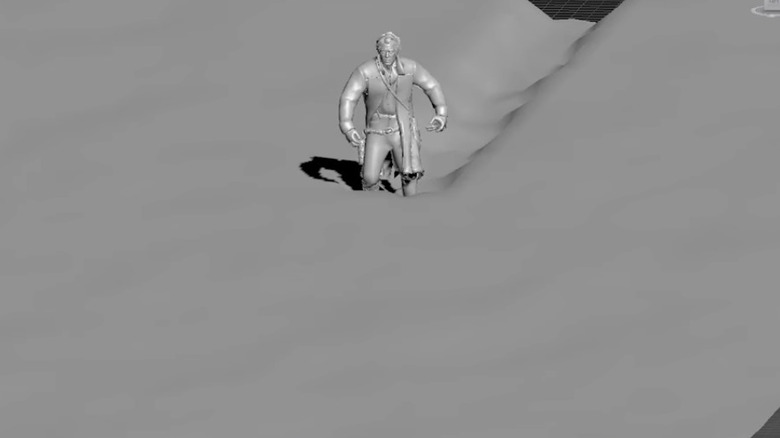What Red Dead Redemption 2 Looks Like Without The Special Effects
"Red Dead Redemption 2" is easily the most ambitious project that Rockstar Games has ever released. And by many accounts, the company succeeded in a big way. The Guardian called it "the most realistic video game ever made," and while a true-to-life Western experience won't please every gamer out there, the subtle design elements that went into creating the world of "Red Dead Redemption 2" have changed gaming forever.
The depth promised by "Red Dead Redemption 2" can feel almost too good to be true, and certainly some players will be put off by the slow pacing and overwhelming details in comparison to other Rockstar titles, but it is the culmination of a vision that creative director Dan Houser had over a decade ago. It was also his last game before leaving the company, which means that "Red Dead Redemption 2" marked a turning point for gaming in more ways than one.
Rockstar's most recent Western outing set a new bar for graphics, interactivity, and storytelling in gaming. It's one of the best-looking games of all time, and it offers players more freedom than most other games even aspire to. But this level of realism didn't happen overnight. In fact, you might be surprised by how different "Red Dead Redemption 2" would look and feel without the sound, direction, and special effects present in the final product.
Writing Red Dead Redemption 2 was a challenge on its own
Behind the layers of graphics and code that create the world of "Red Dead Redemption 2" is a script. Since the first "Red Dead Redemption" set a new bar for storytelling in video games, it's no surprise that Rockstar made the story a top priority in this sequel. Before filming or animating anything — and in order to offer players the most impressive array of main story missions, side quests, and in-game interactions that they'd ever seen — Rockstar had to write a ridiculous amount of material.
In an interview with Vulture, Rockstar's then-vice-president for creative, Dan Houser, said that the final script for "Red Dead Redemption 2" was well over 2,000 pages. He said that the game's NPCs "have 80-page scripts – each." By Houser's estimate, if the script's pages were stacked up, the total page count "would be eight feet high." There are literally hundreds of thousands of spoken lines of dialogue in the final game.
Even for a game whose main story runs well over 60 hours, that's a shocking amount of written content. Of course, writing that many lines of dialogue is a big challenge, but getting it all filmed and recorded is something of a different magnitude entirely.
Bigger than a movie production
As you might imagine for a game as ambitious as "Red Dead Redemption 2," the team working on it was huge. The game is the product of Rockstar's worldwide network of studios, a team of over 1,600 people, and more than seven years worth of effort (via The Guardian). Everything from designing the game's look, to creating its AI, to animating its world took an incredible amount of work, but one of the most labor-intensive parts of its creation was the motion capture.
Dan Houser told Vulture that while creating "Read Dead Redemption 2," Rockstar became "the biggest employers of actors in terms of numbers of anyone in New York, by miles." When Rockstar made "Grand Theft Auto 3," the company spent five days doing motion capture, but this game took 2,200 days of filming. For the process, Rockstar hired 1,200 SAG-AFTRA actors for motion capture work, and 700 of them had speaking lines. With those numbers, "Red Dead Redemption 2" is one of the biggest theatrical productions of all time, video game or otherwise.
And as it turns out, many of those actors would go on to play multiple characters, though you'd never know it after the animation was completed.
Casting the actors
Most people had never heard of the actors involved in "Red Dead Redemption 2," and that's exactly what Rockstar wanted. "We don't bring in name actors anymore because of their egos and, most important of all, because we believe we get a better sense of immersion using talented actors whose voices you don't recognize," Dan Houser told Vulture.
However, casting so many actors also presented Rockstar with a new challenge: maintaining secrecy. Video game studios often like to play things close to the chest, but Rockstar wanted to keep "Red Dead Redemption 2" top secret for as long as possible. That meant filling all the game's roles without telling a single actor what they were actually auditioning for.
On a panel at SacAnime Summer 2019, the main cast of the game explained that none of them knew they were going to be in "Red Dead Redemption 2" until they'd already gotten their parts and had come in for filming. Even Robert Allen Wiethoff, who played John Marston in the first game, thought he was auditioning for a video game commercial.
In addition to reading their lines for the audition, actors also had to perform unexplained actions like folding laundry, walking in circles, or, as Roger Clark explained in an interview at MCM Comic Con, crouching and strafing like a video game character. He said his walk, which players would eventually spend hours looking at, was of major interest to the casting team.
Getting into character
Motion capture is almost like magic. It lets studios do almost anything with an actor's performance. Roger Clark explained in an interview with BAFTA New York how motion capture combines the strengths of film with the strengths of video games. "Your face is in constant close-up because you've got the camera pointed at it, and of course the camera can be anywhere, and they can change it in post, too." The studio can transition seamlessly from close-ups to wide shots, and, if needed, animators can even make changes to an actor's movements or facial expressions weeks or months after the shoot. Regardless of how a scene was filmed, the actual game may present it in an entirely different way.
As amazing as motion capture technology is, it also presents actors with some unique challenges. They have to learn how to get into character while wearing goofy mocap suits instead of costumes and while standing in clean studios instead of real sets. They might even have to play entirely different characters from time to time.
Speaking with IGN, Roger Clark said that whenever it was time for him to act as his main role, Clark would wear a gun holster and cowboy boots to get into the zone as Arthur Morgan. However, he also played "probably two dozen" characters in different scenes throughout the game. At one point, he had to pretend to be Mary standing at his own grave site, and on another day, he got to play the role of a bear mauling someone caught in a bear trap. In other words, without the final animation, you might find yourself looking at dozens of Roger Clarks in any given scene.
Animators assisted the actors
All your favorite scenes in "Red Dead Redemption 2" looked very different to the people who were making them. Benjamin Byron Davis succinctly described the experience, saying, "It was performance capture, so we were in skin tight spandex, covered with ping pong balls with helmets on our head." Of course, sometimes the actors were in a vocal booth recording lines, but most of their work was spent in these ball-covered suits.
The animators were the people who transformed those silly-looking suits and empty filming studios into the breathtakingly beautiful game that everyone loves today. Shots of people sitting on the ground of a green studio became moody campfire scenes or a bustling saloon. And as you can see from early animatics (via Boundary Break), the team went through quite a process in making the game look as realistic as it became, adding one layer after another to each character and set.
Because the animators knew everything about the game's various scenes, they were key members of the filming crew, as well. Roger Clark explained that animators were present at every shoot, and they'd bring along rough mock-ups of how each scene would look in the finished game to help the actors and camera crew. It was the animators who instructed the actors on how to properly respond to the environment around them. Any time characters are shivering in the cold or swatting at flies in the humidity, it's because the animators were there to guide the actors into those high fidelity actions.
A world at your fingertips
From the very beginning of the development process, Rockstar wanted to use "Red Dead Redemption 2" to craft a game world that took realism to the next level. Phil Hooker, the game's technical director, told The Guardian that the goal was to have a game where players would "be able to interact with anybody and for them to feel like a human being." Of course, that's much easier said than done. "The number and combinations of animations we needed to do that, and the systems we needed to put that together, were a lot more complex than ever before."
Rockstar had made some pretty massive games in the past, but "Red Dead Redemption 2" really took things to another level. "If we'd known how much work it was going to be, then maybe we'd have backed off," Dan Houser admitted to GQ. Instead, the company forged ahead and completely updated their AI system for the first time in almost two decades. Doing so allowed Rockstar to give players a cohesive, continuously evolving world with NPCs that respond realistically to player interaction with over half a million different animations.
The next time someone is chasing you down because you killed their cousin in the next town over, you can thank Rockstar's coders for all their effort. It took a number of moving parts to bring even the smallest scripted events to life.
Animating the animals
Animal life is obviously a huge part of "Red Dead Redemption 2." The game features animal companions like dogs and horses, as well as over 200 different animal species that players can encounter, hunt, and eat. Rockstar used a mix of animation and motion capture to create the game's animals, sometimes even calling on the talents of real animals.
Trained horses were brought in for some motion capture sessions, and according to Polygon, Rockstar "used the same technology usually meant for faces on specific areas of the horse's muscles" to make the animals look as realistic as possible in-game. As noted by PCGamesN, that realism famously went as far as to simulate certain (ahem) parts of the horses shrinking in cold weather.
Roger Clark has explained that while many of the game's actors never worked directly with the horses, they did get to spend some time with some real animals. Clark, for instance, got to perform some motion capture alongside trained dogs to nail down the animations between Arthur and his canine companions. According to Clark, working with the dogs could be "a problem," because they were so excited that their wagging tails would throw off the balls of the motion capture suit. That's right; all the onscreen dog action in "Red Dead Redemption 2" is genuine puppy love, perfectly translated to animation.
Next level sound design
Plenty of people have noticed how good "Red Dead Redemption 2" looks, and rightfully so. The game is a perfect example of how far video games have progressed in the last decade from a visual standpoint. Perhaps because of this, less attention has been given to the game's sound design, despite the incredible effort Rockstar put into it. Starting with the score, composer Woody Jackson wrote nearly 200 musical pieces for the game, all of which correspond naturally to what's actually happening onscreen at any given moment.
Even more impressive than the game's score are the ambient noises that permeate every scene. Some reviewers have noted how incredibly accurate all the weapons' sounds are, even when compared to other Rockstar games. There are also unique sounds for every one of the hundreds of different animal species that players can encounter. That, combined with the realistically designed weather effects and a careful system of fading between sound effects creates a sonic experience unlike any other in gaming. It's difficult to imagine how empty the game would sound without this brilliant design.
Creating the weather
The world of "Red Dead Redemption 2" wouldn't feel as realistic as it does without the wide variety of weather that players encounter throughout the story. Rockstar wanted the environment to feel like an active participant in the game, which would in turn give players the authentic sense of surviving in the wilderness.
One of the best examples of the work Rockstar put into the game's weather is the opening chapter. At the beginning of "Red Dead Redemption 2," Arthur and his gang are forced to trudge up to an isolated mountain in the midst of a blizzard. Dan Houser told GQ that he wanted players "to feel trapped up there," but the first draft of the chapter wasn't giving the right atmosphere.
The developers rebuilt the chapter from scratch, narrowed the scope of it, and spent hours carefully crafting the snow and Arthur's movement through it to finally create the perfect sense of entrapment. The studio then carried that level of effort into every other setting in the game, making every moment feel incredibly real.

